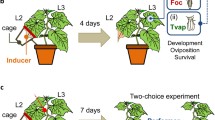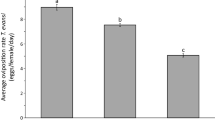Abstract
Evidence is accumulating that herbivorous arthropods do not simply select host plants based on their quality, but also on the predation risk associated with different host plants. It has been suggested that herbivores exclude plant species with high predation risk from their host range. This assumes a constant, predictable predation risk as well as a rather static behaviour on the part of the herbivore; plants are ignored irrespective of the actual predation risk. We show that adult females of a small herbivore, the whitefly Bemisia tabaci, can learn to avoid plants with predatory mites that attack only juvenile whiteflies, while they accept host plants of the same species without predators. Predatory mites disperse more slowly than whiteflies; they cannot fly and walk from plant to plant. Hence, by avoiding plants with predators, the whiteflies create a temporary refuge for their offspring. We suggest that the experience of arthropod herbivores with risks associated with host plants plays an important role in their host plant selection.

Similar content being viewed by others
References
Ballabeni P, Wlodarczyk M, Rahier M (2001) Does enemy-free space for eggs contribute to a leaf beetle's oviposition preference for a nutritionally inferior host plant? Funct Ecol 15:318–324
Bernays EA (1999) When host choice is a problem for a generalist herbivore: experiments with the whitefly, Bemisia tabaci. Ecol Entomol 24:260–267
Bernays E, Graham M (1988) On the evolution of host specificity in phytophagous arthropods. Ecology 69:886–892
Byrne DN, Bellows TS (1991) Whitefly biology. Annu Rev Entomol 36:431–457
Chesson J (1984) Effect of notonectids (Hermiptera: Notonectidae) on mosquitoes (Diptera: Culicidae): predation or selective oviposition? Environ Entomol 13:531–538
Cunningham JP, West SA, Zalucki MP (2001) Host selection in phytophagous insects: a new explanation for learning in adults. Oikos 95:537–543
Faraji F, Janssen A, Sabelis MW (2001) Predatory mites avoid ovipositing near counterattacking prey. Exp Appl Acarol 25:613–623
Freitas AVL, Oliveira PS (1996) Ants as selective agents on herbivore biology: effects on the behaviour of a non-myrmecophilous butterfly. J Anim Ecol 65:205–210
Grostal P, Dicke M (1999) Direct and indirect cues of predation risk influence behavior and reproduction of prey: a case for acarine interactions. Behav Ecol 10:422–427
Grostal P, Dicke M (2000) Recognising one's enemies: a functional approach to risk assessment by prey. Behav Ecol Sociobiol 47:258–264
Jaenike J (1990) Host specialization in phytophagous insects. Annu Rev Ecol Syst 21:243–273
Janssen A (1999) Plants with spider-mite prey attract more predatory mites than clean plants under greenhouse conditions. Entomol Exp Appl 90:191–198
Keefe M (1992) Chemically mediated avoidance-behavior in wild brook trout, Salvelinus fontinalis —the response to familiar and unfamiliar predaceous fishes and the influence of fish diet. Can J Zool 70:288–292
Laurila A, Kujasalo J, Ranta E (1997) Different antipredator behaviour in two anuran tadpoles: effects of predator diet. Behav Ecol Sociobiol 40:329–336
Leather SR, Awmack CS (2002) Does variation in offspring size reflect strenght of preference performance index in herbivorous insects? Oikos 96:192–195
Lill JT, Marquis RJ, Ricklefs RE (2002) Host plants influence parasitism of forest caterpillars. Nature 417:170–173
Mappes J, Kaitala A (1995) Host-plant selection and predation risk for offspring of the parent bug. Ecology 76:2668–2670
Mayhew PJ (1997) Adaptive patterns of host-plant selection by phytophagous insects. Oikos 79:417–428
Nomikou M, Janssen A, Schraag R, Sabelis MW (2001) Phytoseiid predators as potential biological control agents for Bemisia tabaci. Exp Appl Acarol 25:271–291
Nomikou M, Janssen A, Schraag R, Sabelis MW (2002) Phytoseiid predators suppress populations of Bemisia tabaci in the presence of alternative food. Exp Appl Acarol 27:57–68
Ohsaki N, Sato Y (1994) Food plant choice of Pieris butterflies as a trade-off between parasitoid avoidance and quality of plants. Ecology 75:59–68
Overmeer WPJ (1985) Rearing and handling. In: Helle W, Sabelis MW (eds) Spider mites, their biology, natural enemies and control, vol 1b. Elsevier, Amsterdam, pp 162–170
Pallini A, Janssen A, Sabelis MW (1999) Spider mites avoid plants with predators. Exp Appl Acarol 23:803–815
Persons MH, Walker SE, Rypstra AL, Marshall SD (2001) Wolf spider predator avoidance tactics and survival in the presence of diet-associated predator cues (Araneae: Lycosidae). Anim Behav 61:43–51
Petranka JW, Fakhoury K (1991) Evidence of a chemically-mediated avoidance-response of ovipositing insects to blue-gills and green frog tadpoles. Copeia 70:234–239
Resetarits WJ, Wilbur HM (1989) Choice of oviposition site by Hyla chrysoscelis—role of predators and competitors. Ecology 70:220–228
Scheirs J, De Bruyn L (2002) Temporal variability of top-down forces and their role in host choice evolution of phytophagous arthropods. Oikos 97:139–144
Sih A, Crowley P, McPeek M, Petranka JW, Strohmeier K (1985) Predation, competition and prey communities: a review of field experiments. Annu Rev Ecol Syst 16:269-311
Thompson JN (1988) Evolutionary ecology of the relationship between oviposition preference and performance of offspring in phytophagous insects. Entomol Exp Appl 47:3–14
Thompson JN, Pellmyr O (1991) Evolution of oviposition behavior and host preference in lepidoptera. Annu Rev Entomol 36:65–89
Venzon M, Janssen A, Pallini A, Sabelis MW (2000) Diet of a polyphagous arthropod predator affects refuge seeking of its thrips prey. Anim Behav 60:369–375
West SA, Cunningham JP (2002) A general model for host plant selection in phytophagous insects. J Theor Biol 214:499–513
Yamaga Y, Ohgushi T (1999) Preference-performance linkage in a herbivorous lady beetle: consequences of variability of natural enemies. Oecologia 119:183–190
Acknowledgements
We thank Sara Magalhães, Marta Montserrat, Erik van Gool, Nicola Tiën and Farid Faraji for discussions and Luděk Tikovský and Harold Lemereis for arrangements in the greenhouse. Two anonymous referees provided valuable comments. M. N. was financed by the Technology Foundation STW (ABI. 4165), A. J. by the Netherlands Organization for Scientific Research (NWO) within the framework of a PIONIER grant (no. 030-84-469) awarded to A. M. de Roos.
Author information
Authors and Affiliations
Corresponding author
Rights and permissions
About this article
Cite this article
Nomikou, M., Janssen, A. & Sabelis, M.W. Herbivore host plant selection: whitefly learns to avoid host plants that harbour predators of her offspring. Oecologia 136, 484–488 (2003). https://doi.org/10.1007/s00442-003-1289-1
Received:
Accepted:
Published:
Issue Date:
DOI: https://doi.org/10.1007/s00442-003-1289-1




